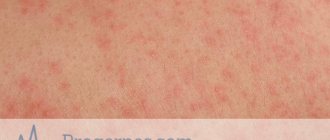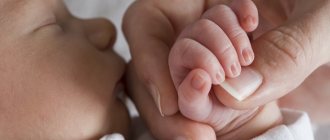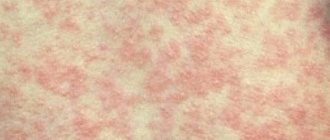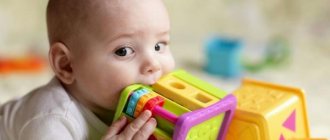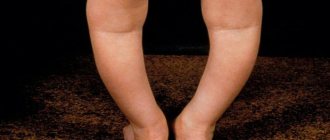2700
Miliaria is a frequently occurring pathology that manifests itself as a rash and redness of the skin or the formation of flesh-colored papules. Miliaria is a reaction of the epidermis to irritation by increased sweat secretions. Many young mothers are concerned about how heat rash in newborns is treated and how it progresses. And are there any differences between the course of this disease in an infant (that is, a child of the first year of life plus/minus six months) and in a newborn (that is, a baby who is less than 28 days old). It's worth looking into.
Features of the newborn period
There are certain significant periods in a child’s life, one of them is the very first, the newborn period. It begins from the moment the baby’s umbilical cord is cut and his breathing and blood flow become autonomous. The newborn period or neonatal period ends at the end of the first month of the baby's life. The essence of this time is the baby’s adaptation to existence outside the womb.
Doctors divide the neonatal period into an early stage (lasts 1-7 days) and a late stage (equal to 7-28 days). All organs and systems of the baby are still immature at this moment - both morphologically and in their functional activity. When a baby is born, an active restructuring of organs and systems begins, its goal is to adapt the baby’s body to existence outside the womb, to external conditions.
A very important feature of the newborn period is the instability of the balance in which the baby’s organs are located. Even minimal changes can affect the child's internal state.
Prickly heat or something else
The work of the sweat glands has not yet been adjusted, so the mother often discovers milia in the baby. These are white dots that appear on the forehead, toes, and cheeks. They are formed due to blocked sweat glands. Milia should never be touched - they will go away on their own in a few weeks. This is not prickly heat!
Another phenomenon with which heat rash in a child is confused is neonatal acne. These are reddish pimples with a whitish purulent tip. They are noticed more often on the face, but they can also be found on the back and neck of the baby. The cause of such rashes is an excess of mother’s hormones in the blood, supported by the still not entirely accurate functioning of the baby’s sweat glands. They go away in two to three months and there is no need to treat them. It is enough to observe hygiene without mistakes. If you are very worried about such rashes of your baby, you can lubricate them with a thin layer of Bepanten from time to time.
The skin of a newborn is supplied with blood much more intensely than that of adults - this is due to the large number of capillaries and their increased diameter. But all damage, if these causes are eliminated, will soon heal. At the same time, the sweat glands are not yet working at 100%.
As a result, the newborn often overheats due to high air temperatures, and also due to very warm vests or diapers.
Heat rash on the face of infants

Prickly heat on the face of babies appears due to the fact that mothers care too much about their children and want to protect them as much as possible from the cold. As a result, the baby overheats and sweats a lot. Usually, heat rash appears on the head if the baby is put on too warm hats. On the face, miliaria appears as a massive, fine, watery rash. The symptoms can be confused with chickenpox, but with smallpox the temperature also rises.
A simple form of miliaria may go away without treatment, but prickly heat must be treated, preferably by consulting a doctor.
How to treat prickly heat on the face in newborns?
- wipe your face with compresses with a solution of chamomile, string or calendula;
- after washing, use baby powder, it will help dry the skin on your face;
- if a child experiences itching, wipe his skin on his face with boiled water with the addition of soda;
- ointment with zinc not only treats the disease, but also relieves itching and heat on the skin; should be applied up to 6 times a day;
Features of children's skin and prickly heat
A baby's skin is thin and very sensitive - you probably know that it is easily irritated by frequent rubbing and touching. Overheating occurs due to the proximity of blood vessels to the skin. The active work of the sweat glands is marked by the formation of ducts, which is why disturbances in sweating occur.
The causes of prickly heat in children are imperfect thermoregulation and overheating. At the same time, it is not necessary to wrap your baby up for several days in a row: the skin reacts to overheating very quickly. Therefore, prickly heat in a newborn is considered a common occurrence.
Types of miliaria:
- Red. There is hyperemia near the nodules and vesicles, but they do not merge with the rash. Miliaria is fixed on the neck, in the groin area, in the armpits. This type of heat rash causes pain when accidentally touched and itching. These rashes may last for a couple of weeks.
- Crystalline. This is a rash in the form of silvery or whitish blisters. They can be on the face, on the neck, on the back, etc. The bubbles merge and form large spots. Peeling occurs in areas of burst formations. This type of rash does not cause pain or discomfort to the baby, and disappears after a day or two.
- Papular. It is a consequence of increased sweating in the baby, such heat rash is noticeable after a few hours. The formations are flesh-colored; they are fixed on the arms and legs, on the back and in the groin. After some time they disappear on their own; such heat rash in a newborn does not need to be treated, just maintain hygiene.
- Miliaria infected. This is what advanced cases of sweating sickness are called if adults did not react in time. This pathology is complicated by the entry of pathogens into the vesicles, which causes the skin tissue to become infected. There is redness on the skin, blisters fill with a yellowish-gray liquid, and it smells bad. At the same time, the baby’s temperature may rise, which is a symptom of the continuation of the infectious process.
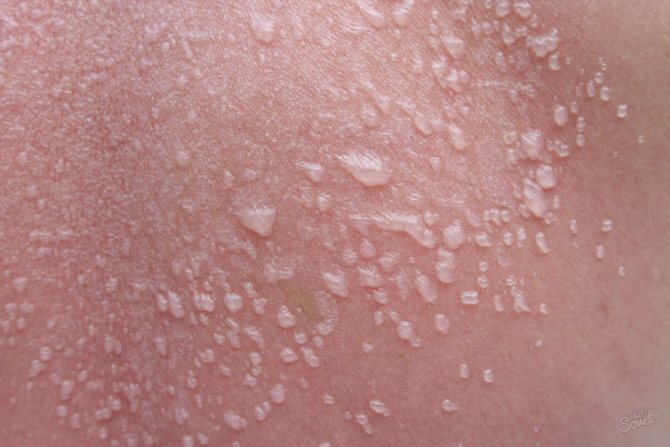
Infected miliaria is dangerous; other cases cannot be called complex.
But quite often, parents confuse a baby’s heat rash with an allergy.
Recommendations from pediatricians
Doctors recommend carefully monitoring infant hygiene and observing temperature conditions. When taking preventive measures, the likelihood of prickly heat occurring is close to zero. If you cannot avoid the rash, it is advisable not to self-medicate, but to consult a doctor. He will help distinguish heat rash from other skin diseases and prescribe a treatment regimen. Most often, for the rash to disappear, it is enough to bathe the child in herbal decoctions and wipe the affected areas with tinctures that have an antiseptic effect. In more advanced cases, medications containing zinc oxide are prescribed.
Some mothers try to cure heat rash on their own using folk remedies. However, it should be remembered that contacting a doctor is inevitable if:
- rashes last on the skin for more than 3 days,
- the fluid in the subcutaneous blisters began to become cloudy - a signal that an infection had entered the wound,
- inflammation gradually increases, the skin turns red and swelling appears,
- ulcers appear,
- wounds become wet and take a long time to heal - a sure sign of a fungal infection.
If your baby has the above symptoms, then it is better not to delay contacting a doctor.
How to distinguish heat rash from allergies
Miliaria is indeed similar to other dermatological ailments. And it is very important to distinguish in time whether a child has heat rash or an allergy.
If the rash is due to an allergic reaction:
- The baby's skin itches, and he tries in every possible way to communicate this - he cries, spins, cannot sleep, reacts to touch;
- The rashes persist even if you take treatment measures. Miliaria quickly responds to treatment - even ordinary air baths reduce the volume of rashes, while allergies give the desired reaction only to adequate treatment and elimination of the allergen;
- If the baby is given an antihistamine, the allergic rash goes away;
- Diathesis rashes resemble scales, and are most often located on the cheeks and limbs.
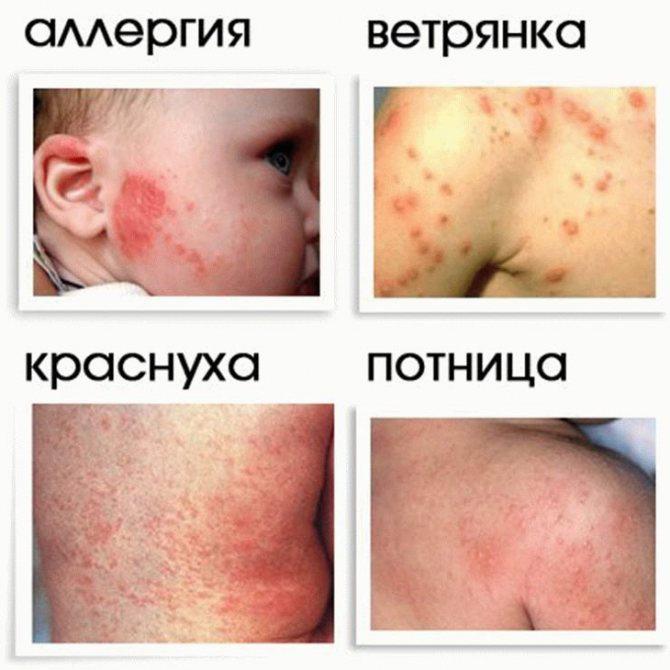
You can see what prickly heat looks like in infants in the photo. If you have any doubts about what it is, it is better to call a doctor. And be sure to think about the cause of the rash. For example, you introduced a new complementary food - then the rash may be an allergy to this product. Or an allergic reaction could be a consequence of having a furry pet at home.
Medicines
To treat prickly heat in infants, medications are prescribed.
- Zinc ointment. Applied directly to rashes, it has an excellent drying and regenerating effect.
- "Bepanthen cream." The most popular remedy for the treatment of prickly heat and a number of other skin diseases. Dexpanthenol, which is part of the drug, perfectly regenerates and moisturizes the skin.
- "Sudocrem". Analogue of zinc ointment. The composition includes zinc oxide and auxiliary elements. The consistency of the cream is quite greasy; it needs to be applied in a thin layer to avoid clogging the pores and worsening the disease.
We advise you to read the material about pemphigus in children, rashes in the form of bubbles on apparently healthy skin.
All listed medications should be used only as prescribed by a doctor.
In addition to the medications mentioned above, there are many other remedies for getting rid of prickly heat. The active ingredient in them is usually the same - zinc oxide. Only a doctor can choose the remedy that is best for the baby.
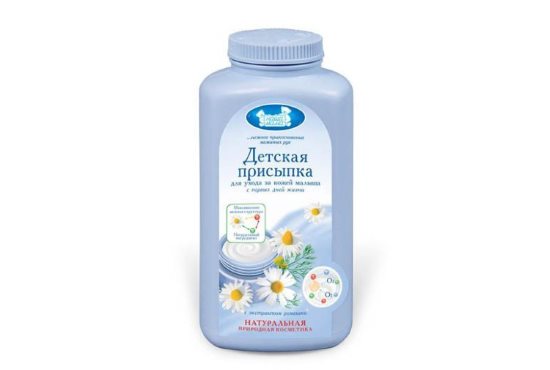
We recommend using powder, not cream, for a baby with heat rash
Why does sweat rash appear?
Miliaria in infants forms in those places where it is more difficult for air to reach. If you wrap a child without taking into account temperature indicators and the season, if you swaddle the baby too tightly (grandmothers are especially guilty of this), overheating will be a natural consequence of such actions, and then sweat rash will appear. The sweat glands produce a secretion that cannot simply evaporate due to the lack of air. And it accumulates excessively, to which the skin reacts with a reaction such as prickly heat.
Why else does this problem occur:
- The room is very hot, stuffy and/or humid - and this circumstance is very common, so you need to carefully monitor the indicators in the room, ventilate it in a timely manner and do a quick wet cleaning every day.
- Rare bathing. The sun, air and water are truly the first friends for a growing organism. The baby needs to be bathed every day. But this is not washing with soap and gels, when the poor child cannot frolic in the water, but lies in the bathtub covered in foam and suffers. This is precisely bathing, when the baby’s body is immersed in water, he enjoys this contact, he feels pleasant and good. You need to wash your baby with soap no more than 1-2 times a week, because he doesn’t run around the streets yet and just doesn’t get dirty.
- Passion for fatty creams. Preparing for the birth of the baby, mother buys various care products for baby skin. And he makes a big mistake: apart from diaper cream, powder and baby soap, a baby under 3-5 months does not need anything. Fatty creams, and even more so oily lotions, clog skin pores and prevent the epidermis from breathing. This also impairs heat transfer.
- Negative reaction to diapers. For example, they are too small for a baby, they pinch and rub, and that’s what causes heat rash in the baby. But more often than not, parents do not change their baby’s diapers on time, and their contents lead to skin irritation.
- Refusal of air baths. Can't do without them! They will simultaneously prevent prickly heat and treat it. Just after the next diaper change, wash your baby, wipe him dry and leave him naked on a safe surface. It is advisable to take air baths in a ventilated room, the procedure time is 10-15 minutes (later – 30-35).
- Tight and very warm clothes. A child who is going for a walk should not resemble cabbage. He definitely doesn’t need a hundred clothes. We looked at how we dressed ourselves and added another layer - this is how you should dress your baby. Just in case, take a blouse or light blanket with you.
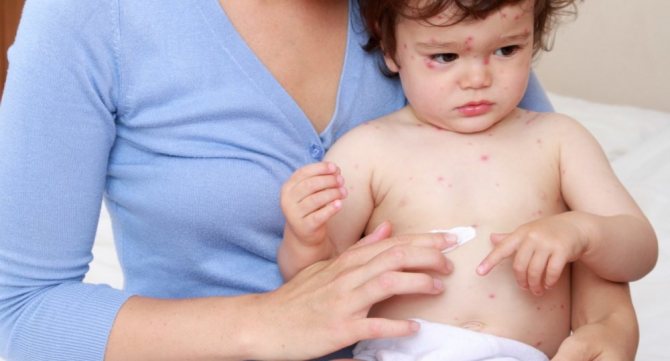
The causes of heat rash contain the answer to the question of how to deal with it. Usually, correcting a problem does not imply treatment as such: you simply focus on hygiene.
If you still think that intensive care for your baby does not give the desired result, before treating heat rash in newborns, find out the opinion of your pediatrician.
Useful tips for treating heat rash in infants
- Feed your baby breast milk, as it strengthens his immune system and gives him emotional strength, which will greatly help him in overcoming the disease.
- Do not apply cream or oil to the rash; this may worsen the situation by causing suppuration in the moistened areas.
- Bathe your baby 3 times a day, or even more. This will help wash away painful discharge. Bath with herbal decoctions 2 times, and with soap - 1 time.
- Do not swaddle your baby tightly, but leave him some space. Otherwise he will continue to sweat, and the treatment will go down the drain.
- Dry your baby's skin gently so as not to damage the pimples.
When to call the doctors
If you see pustules and cracks on your baby’s skin, or notice that he is too whiny and won’t let you touch him, be sure to call a doctor.
Consultation with a specialist is necessary if:
- You notice swelling on the baby's body;
- The blisters on his skin have an unpleasant odor, cracks have formed on the dermis;
- The baby signals pain, burning and itching in every possible way;
- The child's body temperature has increased.
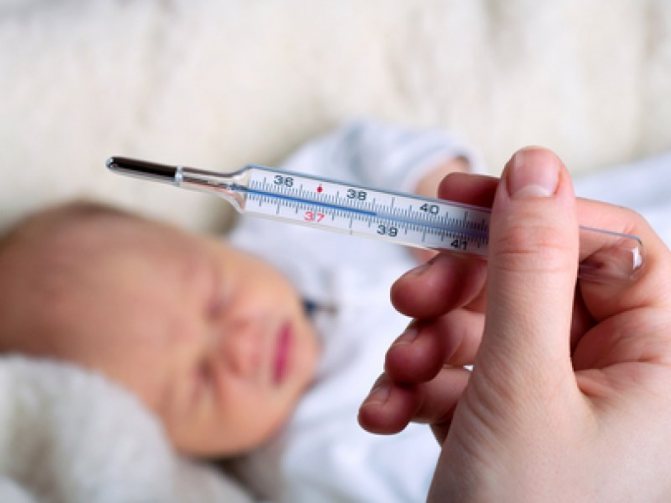
These signs may indicate an infection that has joined an existing illness. Do not wait for the condition to stabilize on its own - purulent formations and cracks are already dangerous and require treatment.
What medications are used to treat prickly heat?
Medicinal ointments help in some cases, but in others they only worsen the situation. For example, if a child has a slight heat rash, and you smear a thick layer of Drapolene or Bepanten on his skin, you can create the very environment that is optimal for the progression of the disease.
What medicinal ointments are often used for heat rash:
- Bepanten is a cream with regenerating properties that well moisturizes damaged epidermis. An alternative would be the less expensive Drapolene.
- Sudocrem. It dries out rashes well and has an antibacterial effect. It treats heat rash well. But it needs to be applied pointwise to the epidermis, since the consistency of the product is very oily.
- Zinc ointment. It dries out the rash quickly and efficiently, allowing you to cope with the disease in about a day and a half.

But still, children's doctors warn parents: do not rush to use creams. Why does a child need medications if the illness can be eliminated without them? Start treatment with frequent air baths and strict adherence to temperature and humidity indicators. Bathe your baby every day (twice in hot weather).
After bathing, gently pat your baby's skin dry without rubbing. After drying, apply powder to problem areas. Just don’t pour it out of the jar, but apply it with a cotton swab. There should be no powder in wet areas (in areas of diaper rash). This product is only suitable for dry areas. If serious diaper rash occurs, the baby should be shown to a pediatrician.
Treatment of heat rash
Maintaining proper hygiene alone can cure heat rash, but if the disease becomes persistent, medication must be used. You can use any of these methods:
- baths with decoctions of medicinal herbs (chamomile, calendula, string) 2 times a day; You can also use decoctions of walnut leaves if the baby is not allergic to them; 3 tbsp. Brew spoons of each plant in 1 liter of water for an hour and strain, then add to bathing water;
- using an ointment containing zinc (sudocrem, zinc ointment or bepanthen); no more than once every 2 days you can bathe in a weak solution of potassium permanganate;
- powders (after bathing) containing zinc oxide or dexpanthenol; to do this, first wipe the baby’s skin dry in all folds;
- wiping the affected areas with antiseptic solutions, such as boric and salicylic acid, furatsilin solution;
- wiping with soda solution (1 tablespoon per 1 glass of boiled water);
- medications that the doctor will prescribe (but still, it is better to use simple, folk methods, so as not to harm the baby’s delicate skin from early childhood);
- If pustules appear, you should definitely consult a doctor; this will require slightly different treatment.
In the groin area you need to use powders with talc and zinc.
If treatment does not help, you should consult a doctor, as it may be a completely different disease, for example, dermatitis.
How to avoid heat rash
Even in hot weather, you can create comfortable conditions for a newborn. Always dress your baby strictly according to the weather, do not overwrap him or swaddle him tightly. Choose loose-fitting clothes for him, only from natural materials, so that the baby’s skin can breathe.
Also follow these recommendations:
- Water treatments – every day, choose the time individually;
- Air baths – also daily;
- There will be no prickly heat on the head if you limit the use of hats;
- Diaper cream is necessary, but it does not need to be applied every time;
- To wash your baby’s clothes, choose special phosphate-free powders.
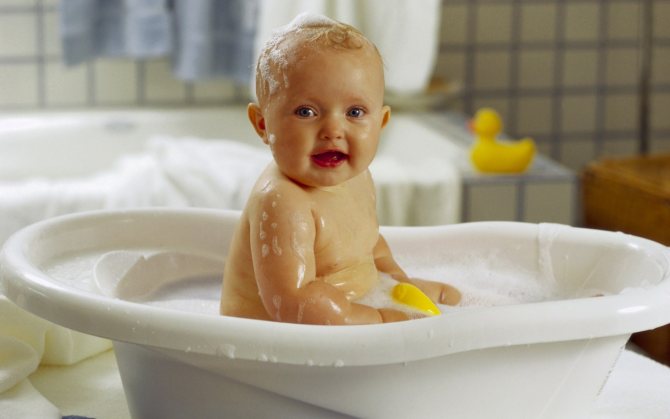
During the walk, monitor the baby’s condition; if he is already wet, his back is wet, there is sweat on his neck and natural folds, end the walk. Carry baby wipes with you, or better yet, a bottle of water and pieces of natural fabrics. If the baby is sweating, wipe his skin with a wet napkin, and change the vest to a dry one (carry a replacement with you). This way you will prevent your baby from prickly heat and its complications.

